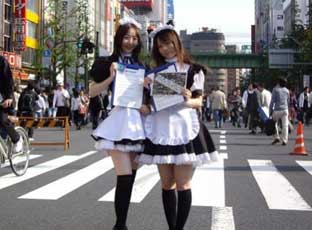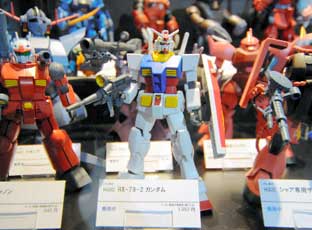
Travel Guide
Introduction
Akihabara is the largest town collecting all kinds of electronic appliances and devices in Japan. The products at the very top of technology are always abundantly available here. Keep an eye out for the many tax-free shops in the area.
Akihabara offers both spacious, convenient, department store-style shopping and out-of-the-way, rabbit-warren-type shopping. But whichever suits you, Akihabara is the number one place in Tokyo for computers, computer games, software, computer accessories, mobile phones, electronic parts, and electric appliances.
As well as for the cameras, computers, TVs and mobile phones, Akihabara is also a treasure trove of manga, games, toys, anime, and anime DVDs. Akihabara attracts hordes of those fascinated by amine and manga culture: the otaku, or, nerds.
Chuo-dori is Akihabara's main shopping street, which runs all the way south through east Tokyo down to Nihonbashi and Ginza. Chuo-dori, especially around Akihabara station, is dominated by major stores, many of which have multiple premises in the area, each dedicated to a different kind of product. The streets off Chuo-dori are generally for smaller, more specialized stores, and are where you will find the best bargains - if you are prepared to hunt.
There are other Akihabara Electric Town attractions and events. On Sundays, Chuo-dori, the main street through the district, is closed to car traffic from 13:00 to 18:00 (until 17:00 from October through March), and becomes a sort of street festival with cosplayers in costumes and local bands entertaining the crowds.
History
Akihabara was once known as Aioi, during the Edo period (1603-1868). The area served as a passage between the city and northwestern Japan. This made the region a home to many craftsmen and tradesmen, as well as some low class samurai. One of Tokyo’s frequent fires destroyed the area in 1869, and the people decided to replace the buildings of the area with a shrine called Chinkasha, meaning fire extinguisher shrine, in an attempt to prevent the spread of future fires. The locals nicknamed the shrine Akiba after a deity that could control fire, and the area around it became known as Akibagahara and later Akihabara.
In 1890, the area's first railway station Akihabara Station was built and became a major freight transit point, which allowed a vegetable and fruit market to spring up in the district. Then, in the 1920s, the station saw a large volume of passengers after opening for public transport.
Akihabara had had numerous electrical appliance dealers even before the World War II. After World War II, the black market thrived in the absence of a strong government. This disconnection of Akihabara from government authority has allowed the district to grow as a market city and given rise to an excellent atmosphere for entrepreneurship. In the 1930s, this climate turned Akihabara into a future-oriented market region specializing in household electronics, such as washing machines, refrigerators, televisions, and stereos, earning Akihabara the nickname Electric Town.
Nowadays, Akihabara is considered by many to be an otaku cultural center and a shopping district for computer goods, video games, anime, and manga. Icons from popular anime and manga are displayed prominently on the shops in the area, and numerous maid cafés are found throughout the district.


Travel Advice
Otaku culture
Otaku in Japanese refers to anyone unusually enthusiastic about and focused on a particular thing or topic. However, otaku is usually used in the context of those with a love and exhaustive knowledge of comic books, or novels in pictures, i.e. manga, and animated cartoons or computer graphics, i.e. anime, and the characters portrayed in them.
The character of Akihabara has constantly changed over the decades and continues to do so. In the last decade Akihabara has emerged as a center of Japanese otaku and anime culture, and dozens of stores specializing in anime, manga, retro video games, figurines, card games and other collectibles have filled the spaces between the electronics retailers.
In addition to shops, various other animation related establishments have become popular in the area, particularly maid cafes where waitresses dress up and act like maids or anime characters, and manga kissaten (comics cafes), a type of internet cafe where customers can read comics and watch DVDs in addition to having access to the internet.
Costumed coffee shops, known as maid cafes, can also be found tucked in-between the electronic shops. These unique establishments frequently feature wait staff dressed as French maids who serve not only food, but they also engage their customers in games and conversation. Some maid cafes have English-speaking maids.
Communication with staff members
It is also one of the few places in Tokyo or Japan where you will find a variety of languages spoken and announcements made. Many of the larger duty free shops have English, Chinese, Korean speaking staff and also in some you can find Spanish, Russian, Hindi, Bengali, Portuguese speaking staff. You can check out the official shop list to see what languages are offered.
Duty free shopping
There are some caveats that the average United States tourist shopping in Akihabara for electronics should heed. If you plan to take use your purchase at home, be aware that many of the devices have voltage and other technical specifications making them suitable only for use in Japan. However, there are many Akihabara stores marketing directly to the Western tourist, and there are even duty free stores where you can purchase items that can be brought home free of duty. A passport is required, and your purchase generally must total at least 10,000 yen. If you are bringing a substantial amount of purchases back home, you should ensure you have the receipts for all items. Additionally, be aware that there is plenty of electronic junk mixed in with good bargains, so you should have at least some expertise in what it is you’re looking to buy if you don’t want to get ripped off. Shopping in Akihabara will reward you with everything from vacuum cleaners and iPods to DVD players and video games.
Visit
| Address | Sotokanda, Chiyoda-ku, Tokyo | |
| Phone | 03-3257-0568 (Akihabara Electronical Town Organization) | |
| Admission | Free | |
| Hours | Free Time | |
| Closed | Open 7 Days a Week | |
| Duration | 1 hour | |
| Getting There | By Train 1 minute walk from Akihabara Station on JR Yamanote Line, Keihin-tohoku Line, Tsukuba Expree, subway Hibiya Line. 3 minutes walk from Suehirocho Station on subway Ginza Line. By Car Take Shuto Expressway to the kandabashi exit. It is approximately 10 minutes from exit. |
|
| Parking | Paid parking available | |

